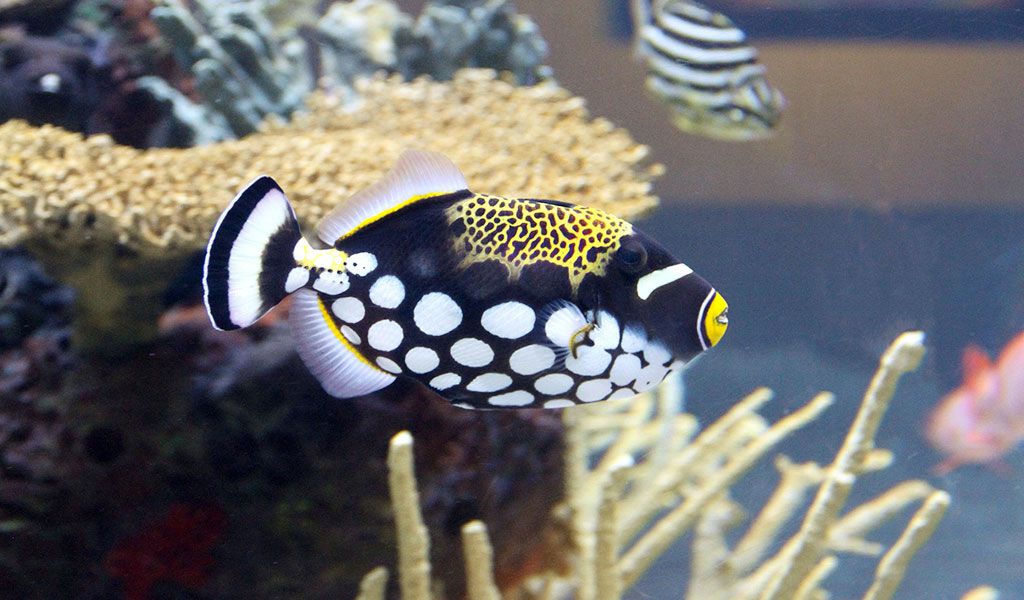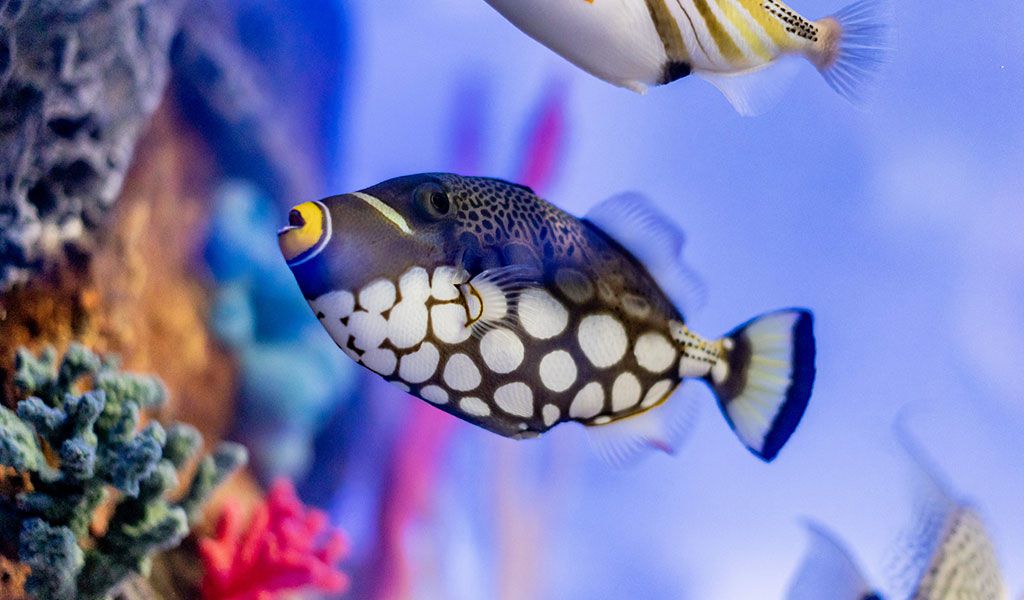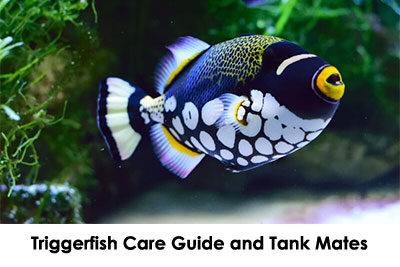Characterized by a compressed body, most triggerfish can grow up to 8–20 inches (20-50 cm). And the average lifespan reaches 7–13 years. For the aggressive behavior and territorial nature, triggerfish are not recommended for beginning aquarists. Next, we will share the triggerfish care guide and tank mates.
Triggerfish care sheet
This segment is mainly to list some basic requirements for triggerfish.
Diet
Triggerfish is omnivore. A viable diet for triggerfish consists of a combination of high-quality commercial foods, meaty foods, and occasional vegetables. You can feed pellets, flakes, frozen or live foods, shrimp, small fish, etc.
Light setting
A regular day-night cycle that mimics the natural environment is beneficial to triggerfish. A consistent lighting time can be approximately 10–12 hours. Also, some triggerfish prefer living in tanks with corals. Thus, moderate to highlight intensity can meet their requirements. Exactly, reef-specific or full-spectrum reef LED lights are commonly used in reef aquariums and can provide the necessary light wavelengths for coral growth and fish health.
Water parameters
Most triggerfish can live in tanks with the following water parameters.
| Water temperature | 75-82℉ (24-28℃) |
| pH level | 8.1-8.4 |
| Specific gravity | 1.020-1.025 |
| Water hardness | 8-12 dKH |
| Calcium level | 380-480 ppm |
| Magnesium level | 1250-1350 ppm |
How many triggerfish are in a fish tank
Fish density in a fish tank depends on the triggerfish species, the tank size, and compatible tank mates. Typically, triggerfish can grow quite large, so the minimum recommended tank size for most triggerfish species is around 75–100 gallons, but larger tanks are preferable for accommodating their size and territorial nature. Also, a general rule is that you should leave at least 60 cm of swimming space per triggerfish.

For some triggerfish species, maintaining a single male-female pair can be successful, as they form monogamous pairs and may exhibit less aggression towards other fish. However, it is essential to ensure adequate space and hiding spots to minimize territorial disputes.
Triggerfish care guide
Tank setup
- Substrate: the substrate should be easy to clean and appropriate for triggerfish.
- Decorations: To establish territories and reduce aggression, it is vital to provide adequate hiding places. You can incorporate plenty of live rock or other forms of rock work to create caves, crevices, and hiding spots. Furthermore, use sturdy decorations as triggerfish can rearrange or knock over objects.
- Filtration: Triggerfish can produce mass waste. Hence, build a high-quality filtration system to maintain water quality.
- Protein skimmer: A protein skimmer can effectively remove organic waste and other pollutants before they break down into compounds that can harm the aquarium inhabitants. And it makes your tank crystal clear.
- Water flow: Provide moderate to strong water flow in the tank to simulate their natural reef habitat.
- Aquarium lid or cover: You should ensure the tank has a secure lid or cover as triggerfish are known to be jumpers.
Daily maintenance
- Monitor water quality: Test the water parameters with aquarium water test strips and aquarium hydrometer.
- Water change: Do regular water changes. For instance, change 15-30 percent of water once every two weeks. While changing aquarium water, you can also clean the triggerfish aquarium.
- Observation: Observe the triggerfish for signs of stress, disease, or aggression, especially changes in behavior, appetite, or physical appearance.
Feeding frequency
Feed triggerfish small amounts of food multiple times a day, providing what they can consume within a few minutes. Avoid overfeeding, as it can lead to health issues and water pollution. If you are on a business trip, an intelligent fish feeder will help you out, which allows remotely feed and monitor fish.
Netting and Handling
Be cautious when netting or handling triggerfish as they have sharp teeth and powerful jaws. Use a specimen container or a container with a lid to capture and move them if necessary.
Compatibility
Not all triggerfish prefer tanks with corals. Some triggerfish species eat corals. They may nip at coral polyps, causing damage or even consuming sections of the coral. This behavior is more common in larger triggerfish species.
If you have a reef tank with delicate or expensive corals, it is generally advisable to avoid adding triggerfish or choose reef-safe species that are less likely to harm the corals. Alternatively, you can use physical barriers, such as mesh or acrylic panels, to protect corals from triggerfish if you still wish to keep them together.

Triggerfish tank mates
Triggerfish are aggressive, especially towards fish of similar size and shape. So avoid keeping them with small or docile species and research species that are known to coexist peacefully with triggerfish or consider a species-only tank. Next, we will list some potential tank mates that are known to be compatible with triggerfish.
Large and robust fish
- Tangs/Surgeonfish: These fish are active swimmers and can hold their own against triggerfish. Avoid similarly shaped species to minimize territorial disputes.
- Large Wrasses: Some larger wrasses, such as the Humphead Wrasse (Cheilinus undulatus), can coexist with triggerfish. Just ensure adequate space and hiding spots for each species.
- Groupers: Larger grouper species can be compatible with triggerfish, but it is essential to provide sufficient space and hiding places for each fish.
Semi-Aggressive Fish
- Dottybacks: Certain dottyback species, like the Orchid Dottyback (Pseudochromis fridmani), can coexist with triggerfish. But do not forget to monitor their behavior and provide ample hiding spots.
- Hawkfish: Some hawkfish species, such as the Flame Hawkfish (Neocirrhites armatus), can be compatible. Also, make sure sufficient space and provide suitable perching spots.
Peaceful and Bottom-Dwelling Fish
- Blennies: Some blenny species, like the Midas Blenny (Ecsenius midas), can be kept with triggerfish. They generally occupy different areas of the tank and have different feeding habits.
- Gobies: Certain goby species, such as the Yellow Watchman Goby (Cryptocentrus cinctus), can coexist peacefully. They inhabit different areas of the tank and have different behaviors.
However, the specific temperament and compatibility of fish can vary within species and individuals. It is crucial to observe the behavior of tank mates after introducing them and be prepared to make adjustments if aggression or territorial disputes arise.
Plus, avoid adding small or passive fish that may be seen as prey or easily harassed by triggerfish. Additionally, be cautious when introducing new fish to an established triggerfish’s territory. It is recommended to have a backup plan or a separate tank available in case the tank mates do not get along.
Final thoughts
No matter which fish species you introduce to triggerfish aquariums, observing after introduction is critically critical, reducing the risk of injury. Plus, though triggerfish is not easy to care for, it definitely adds colors to aquariums.
